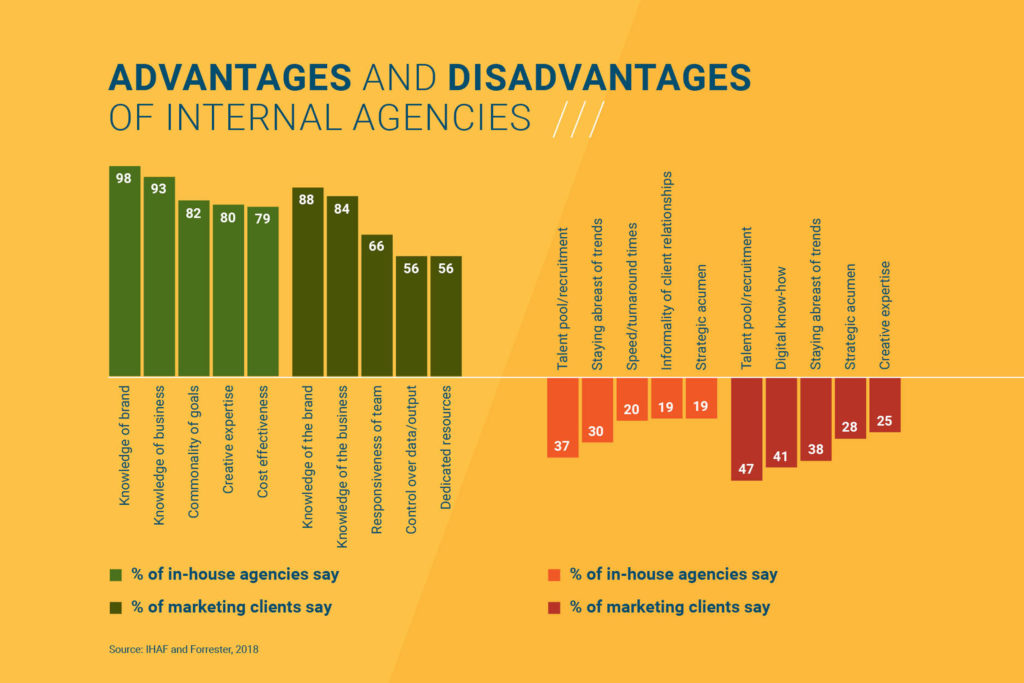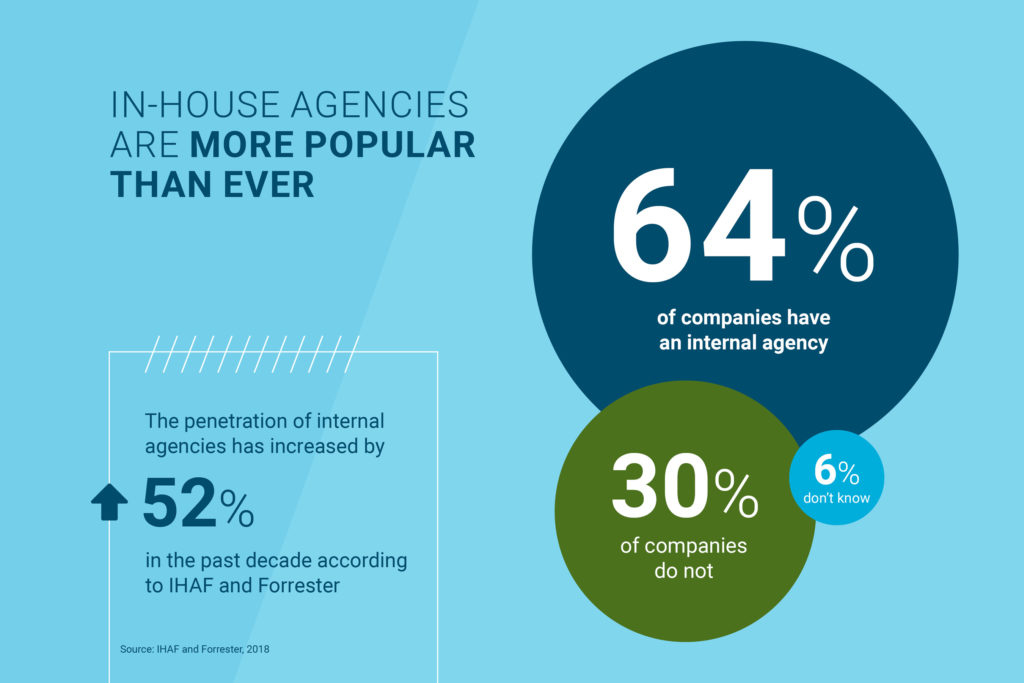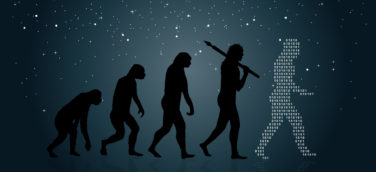What a difference a decade makes. Looking back, 2008 doesn’t seem that long ago until we realize it predated Instagram, Uber, and iPads. It was a year of bankruptcies and bailouts. And, a time when pop culture was lovesick for vampires.
At the In-House Agency Forum (IHAF), we recently put our own industry under the 10-year lens. In partnership with Forrester Research, we fielded and published our 2018 state-of-the-industry report, In-House Agencies Today—an eye-opening contrast to our initial study with the ANA in 2008.
Analyzing 325 unique corporations across major market sectors like healthcare and pharmaceuticals—including in-house agencies, client-side marketers, and external agencies—our goal was to assess the state and impact of today’s corporate creative organizations on their respective brands and the advertising and marketing industry.
 A number of insights surfaced, highlighting just how far in-house agencies have come.
A number of insights surfaced, highlighting just how far in-house agencies have come.
In-house agencies are not a fad.
2018 was a big news year for in-house agencies. Countless articles and points of view emerged debating the merits of the in-house model, its place alongside external advertising agencies, and the “why” behind its seemingly overnight ascent.
As a professional association serving the in-house agency community since 2005, IHAF can attest that in-house agencies are not new. While our 2018 report reveals that 64% of corporations have in-house agencies (an increase of 52% over the past decade), nearly 50% of those corporations have had an internal agency in place for 10 or more years with 27% in place for 20 years plus.
 In-house agencies are multi-disciplined.
In-house agencies are multi-disciplined.
Ten years ago, many brands favored external agencies for their advertising. And, if there was an in-house team in place, that group focused on executing materials that stemmed from external thinking, campaigns, or creative. As in-house agencies have matured, their functions and capabilities have as well—resulting in an expansion of their services.
The top five functional areas that comprise in-house agencies today are: Creative, Digital/Interactive, Video, Account/Project Management, and Print Production. And, the top five capabilities are: Design/Art Direction, Digital Advertising, Copywriting, Print Advertising, and Presentation Design.
It’s important to note that even as more and more work is insourced, fewer than half (41%) of client-side marketers are required to work with their internal agencies. That means that in-house teams must market themselves, often pitching to win business just like an external agency.
In-house agencies know the business and the brand.
The old adage “fast, cheap, good—pick two” appropriately captures the long-held perception of internal agencies. In fact, in 2008, cost efficiencies and turnaround times emerged as the leading advantages of the in-house model. At the same time, these teams were clamoring to prove themselves, get a seat at the table, and show that they could do more than simply execute based on external agencies’ ideas.
Fast forward to today. While cost efficiency and speed to market remain as hallmarks, client-side marketers assert that the top two advantages of having an internal agency are knowledge of the brand and knowledge of the business. Cost and speed are still recognized benefits, but they are no longer the leading motivators for establishing an in-house team.
In-house agencies need to focus on talent.
With growth comes growing pains. And, while in-house agencies are enjoying increases in reputation and demand, they are being called to address specific challenges as they continue to evolve. The leading disadvantage of the model, as reported by client-side marketers and in-house agencies responding to our 2018 study, is talent. That includes:
- Capacity and capability. Given the dynamic nature of marketing today, it is essential for agencies of all types to effectively balance capacity and capability. Internal agencies are no exception. That means ensuring that agencies have both the headcount and the skillsets required to effectively support the business.
- Size of team. The majority of in-house agencies in our study employ fewer than 50 people with 55% reporting an increase in team size over the past year. Even with such growth, 67% of respondents (including client-side marketers) believe that their in-house agencies are understaffed—with not enough people to handle the volume of work.
- Expanded expertise. From a skillset standpoint, digital know-how and creative expertise were cited by client-side marketers as areas of need among in-house agencies. And, both clients and internal agencies agreed that staying abreast of trends is a challenge when working in-house.
- Recruitment of talent. In-house agencies are sometimes gated by geography, with parent companies located in regions that are not highly populated with agency talent. There are also candidates who do not consider working in-house because of lack of awareness, understanding, or affinity for the model.
In-house and external agencies are complementary.
If you’ve read the advertising trades over the past few months, you’ve likely seen some permutation of this question: Internal and external agencies, friends or foes? Our recent study reveals that in-house agencies are increasingly a complement to their external counterparts. In fact, only 30% of external agency respondents indicated that the rise of the in-house model is a threat. Meghan McDonnell, President of Pile and Company, shared, “There is room for everyone at the table. Savvy marketers now conduct reviews that are considerate of a blended model, with external and internal resources as part of any agency search.”
What’s Next for the In-House Model?
Much of an in-house agency’s future-proofing depends on senior support and investment. Leading consultant and in-house influencer, Marta Stiglin, asserts that if brands want to advance their internal capabilities, “C-suite executives need to make deliberate, considered investments in building teams that disprove the stereotype by hiring the best, brightest, most talented people money can buy.” Stiglin adds, “They’re out there and not all of them want to work for an external agency.”
Roger Hyde, VP of Advertising and Creative Services at AT&T agrees: “We have committed to hiring the same caliber of talent as our external agencies, which means equal compensation, a first-rate infrastructure with enviable tools to lure and retain the best candidates, and a flawless project management function.”
Investing in talent will not only enhance today’s mastery of the business and command of the brand, it will advance the digital and creative prowess that clients are calling for from in-house teams. With top talent in place, in-house agencies will be better able to partner with their client counterparts, ensuring resources are expended in ways and on work that has the highest potential to benefit the company. This is also the way to benefit the in-house model, securing its position and viability for the next 10 years.
To download a free infographic of key findings from our recent study, In-House Agencies Today, go to www.ihaforum.org/in-house-agencies-today.









